
Traditionally, many plumbing businesses relied on word-of-mouth referrals to attract new clients.
However, in today’s digital age, this approach may limit growth potential. A significant number of consumers now turn to search engines like Google to find local plumbing services.
In the United States, at least 131,000 people type the words “plumber near me” into Google each month.
That’s not to mention other terms like:
- Emergency plumber
- 24 hour plumber
- Same day plumber
In fact, it’s likely that millions of people search for a plumber online each year.
This article explains how plumbers can use search engine optimization (SEO) to tap into this vast online market.
We’ll discuss strategies such as creating valuable content, building high-quality backlinks, and optimizing on-page SEO to enhance your online visibility and attract more customers.
What Is SEO for Plumbers?
SEO is the process of improving your website so it appears higher in search engine results on platforms like Google.
When someone searches for a plumber in their area—by typing something like “emergency plumber”—Google decides which websites to show based on how relevant and trustworthy they seem.
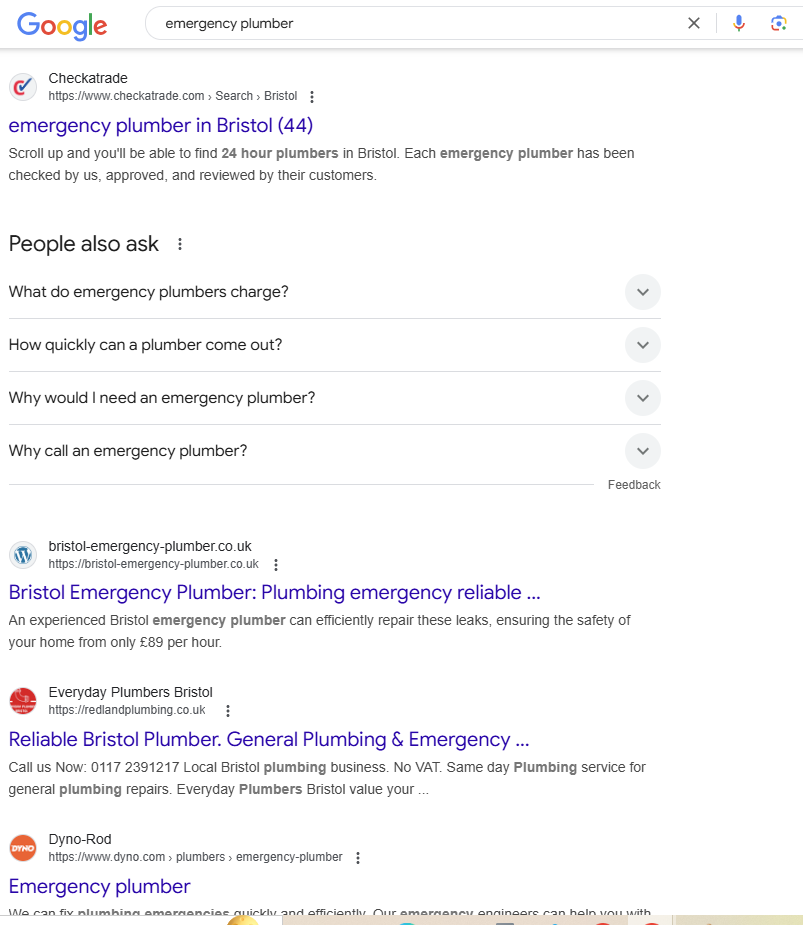
Ranking matters because most people visit one of the first few results they see. In fact, the first search result gets nearly 40% of all clicks. Results on page two, get almost no clicks at all.
For plumbers, ranking higher in search results means more visitors to your site and, ultimately, more customers calling for your services.
SEO involves optimizing different parts of your website. Examples include:
- Its structure
- How fast it loads
- The words you use (known as keywords in SEO circles)
- Ensuring your business is listed correctly on sites like Google Maps so local customers can easily find you.
Ranking high on Google is the main result of this. But what are the other benefits of SEO? Read the next section to find out.
Benefits of SEO for plumbers
Investing in SEO offers plumbers several important benefits:
More website traffic
When your website ranks higher in search results, more people will visit it. For example, if someone searches “24/7 plumber near me” and your site appears at the top, you’re more likely to get their business.
Local customer focus
SEO helps you target customers in your service area. With strategies like optimizing for “plumber in [your city],” you’ll attract people who actually need a plumber nearby.
Increased calls and bookings
A well-optimized website doesn’t just attract visitors—it converts them into customers. SEO drives more calls and jobs by making it easy for potential clients to find your phone number or book an appointment.
Competitive advantage
Many plumbers still rely on word-of-mouth or traditional advertising. By focusing on SEO, you can outrank competitors who haven’t yet invested in their online presence.
Long-term results
Unlike paid ads, which stop working once you stop paying, SEO delivers lasting results. Over time, your website can keep bringing in new customers without constant investment.
By improving your online visibility, SEO ensures your plumbing business grows.
Great returns
SEO is well worth the investment. For example, let’s say after a lot of work you start ranking number one for the term “plumber chicago”.
This term gets around 1,500 monthly searches. As number one, you can expect to get about 585 of these searches each month.
You can expect about 2% of these visitors to convert into paying customers. That’s at least 11 customers per month.
The average plumbing job is worth $315.
11 x $315 is $3,465 per month, or $41,580 per year.
Most businesses spend at least $500 per month on SEO, leaving you with an ROI of $35,580!
Factors search engines use to rank websites
Search engines like Google use a variety of factors to decide which websites appear first in search results. Here are some of the key ones:
Relevance of content
Google looks at how well the content on your site matches what a user is searching for. For example, if someone searches “pipe repair tips,” an in-depth guide on the subject is more likely to rank than a general article about plumbing.
Quality of content
High-quality, well-written content that provides value to the reader ranks better. This means avoiding fluff, answering common questions, and including helpful details, such as how-tos or solutions to plumbing issues.
Local SEO signals
For plumbers, local factors are especially important. Google considers things like your business’s proximity to the searcher, customer reviews, and whether your business information (name, address, phone number) is consistent across platforms.
Website speed and mobile friendliness
A slow or hard-to-navigate website won’t rank well. Your site should load quickly and be easy to use on mobile phones since many customers search from their smartphones.
Backlinks
Backlinks are links from other websites to yours. When other reputable websites link to your site, it signals to Google that your business is trustworthy.
User experience
Google pays attention to how visitors interact with your website. If people quickly leave your site because it’s confusing or unhelpful, it could hurt your rankings.
By optimizing these factors, you can improve your chances of ranking higher in search results and attracting more customers.
How Plumbers Can Boost Their SEO
1. Set up your local SEO
Local SEO focuses on helping your business appear in search results when people in your area search for services.
For example, if someone types “plumber near me” into Google, local SEO increases the chances your business will show up.
Plumbing is a local service—customers need someone who can arrive quickly and fix the problem.
What do local SEO results look like?
When you search for a service on Google, you’ll often see a map with three businesses listed below it. This section is called the “Local Pack.” It includes the business’s name, address, phone number, website link, and customer reviews.
Ranking in this Local Pack is a top priority for plumbers because it’s one of the first things searchers see.
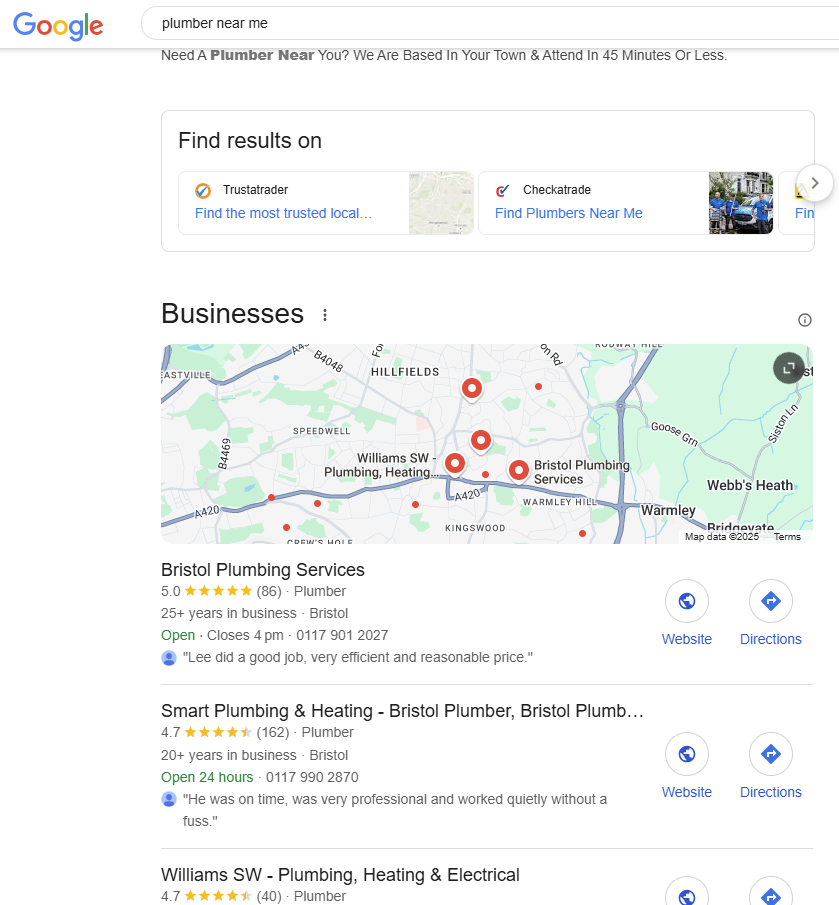
How to improve local SEO
Here are some key strategies plumbers can use to improve their local SEO:
- Ensure NAP consistency: Ensure your Name, Address, and Phone number (NAP) are the same across your website, directories, and social media profiles.
- Encourage online reviews: Ask satisfied customers to leave reviews on Google or other review platforms.
- Optimize for local keywords: Use location-specific phrases like “plumber in [city name]” throughout your website content.
- Create localized content: Write blog posts or FAQs that target local issues or events relevant to your plumbing services.
- Use local directories: List your business on local online directories like Yelp, Yellow Pages, and Angie’s List.
- Set up, optimize, and manage your Google Business Profile: This is one of the most powerful tools for improving your local SEO. The following section explains it in greater detail.
How to set up your Google Business Profile
Google Business Profile (formerly Google My Business) is a free tool that lets you manage how your business appears on Google Search and Google Maps.
For plumbers, this is crucial because it ensures your business shows up in the Local Pack when potential customers search for plumbing services in your area.
Steps to set up your Google Business Profile:
Step 1: Go to Google Business Profile and sign in with your Google account.
Step 2: Click “Manage now” and search for your business name to see if it’s already listed. If not, click “Add your business to Google.”
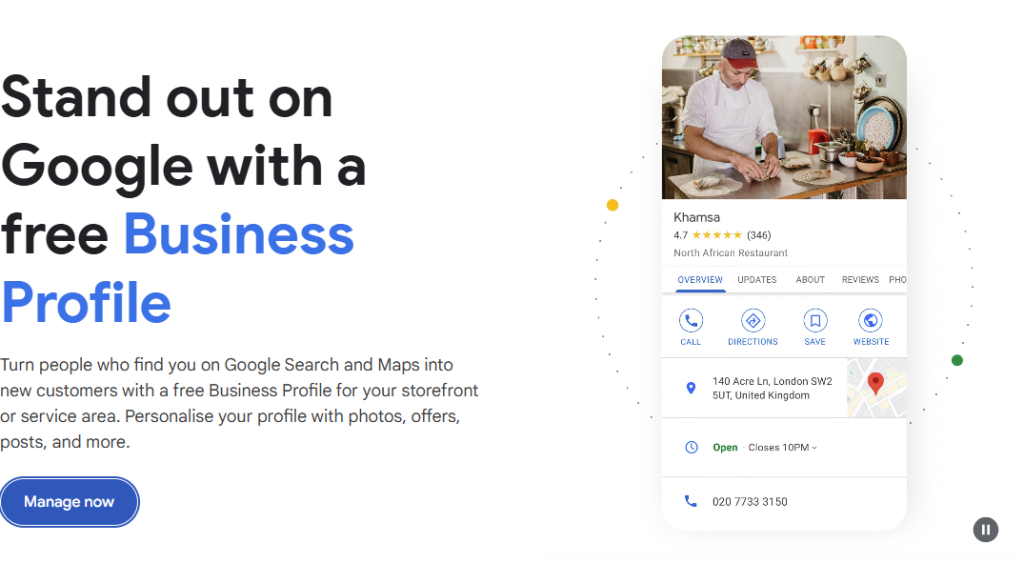
Step 3: Enter your business name, address, phone number, and website when prompted. Make sure to select the appropriate category, such as “Plumber.”
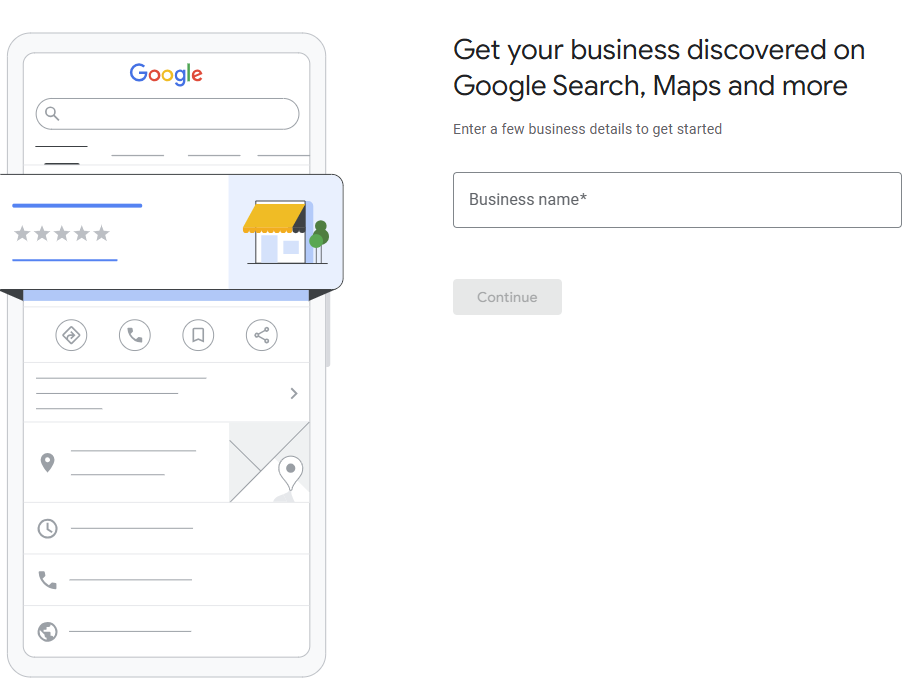
Step 4: Verify your business. Google will send you a postcard with a verification code to your listed address. Enter the code once you receive it.
Step 5: Add photos of your business, logo, and services. Complete your profile with accurate details, including your service area, business hours, and a description of your services.
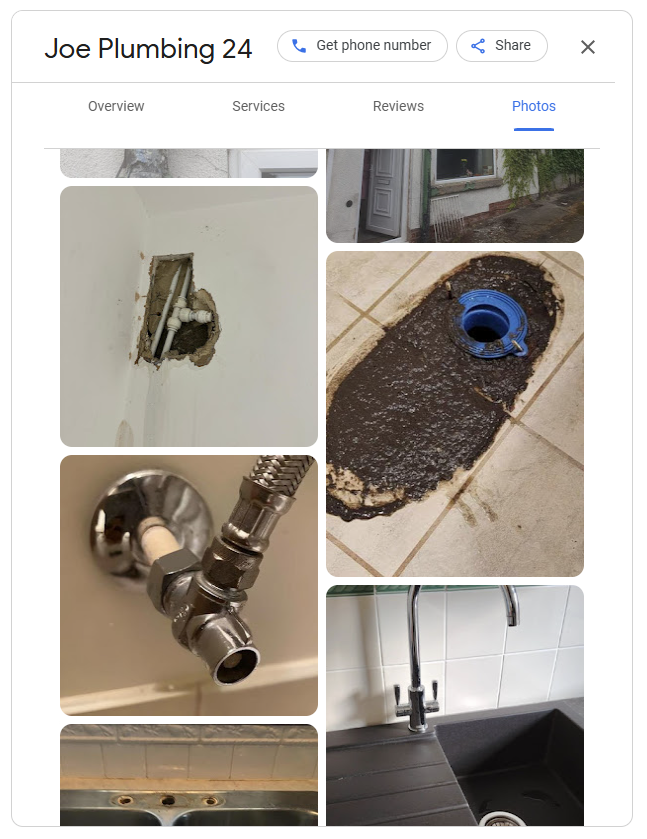
It’s also important to ensure your Google Business Profile stays current. Regularly update your hours, post new photos, and respond to customer reviews to keep your profile active and accurate.
2. Post on social media
Social media is a great way for plumbers to connect with potential customers and improve their local SEO.
Platforms like Facebook, Instagram, and Twitter allow you to share updates, showcase your work, and interact directly with your audience.
Posting regularly on social media can help you stay top-of-mind for people in your area who may need plumbing services.
Your posts could include:
🔧 Before-and-after photos of jobs
🔧 Tips for home plumbing maintenance
🔧 Customer testimonials
🔧 New hires
🔧 Any charity work you have undertaken
🔧 Answer people’s plumbing queries
These types of posts not only show your expertise but also engage your audience.
For example, in this post, SS Plumbing Heating and Excavating displays photos of a recent job they completed.
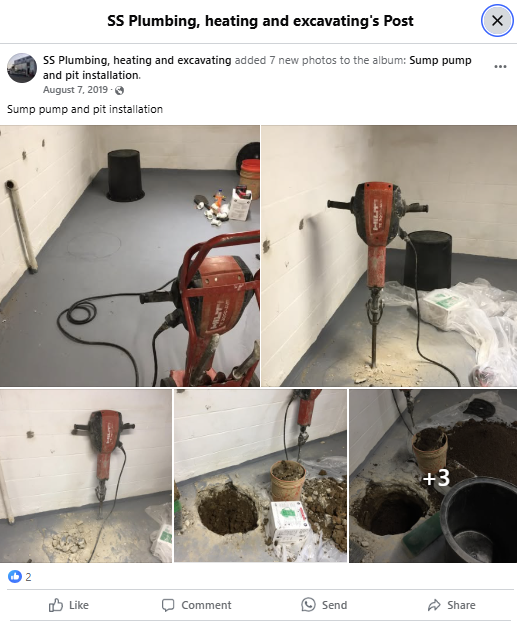
This shows the companies’ expertise and that they are able to take on challenging jobs in people’s homes.
Find relevant keywords
Keywords are the words and phrases people type into search engines when looking for something. For plumbers, these could be terms like:
- Emergency plumber
- Pipe repair in [city]
- Clogged drain services
You can add keywords and related terms to your content and website. This helps search engines understand what your website is about and ensures it appears in relevant searches.
How do keywords work?
When someone types a keyword into a search engine, it looks for web pages that are most relevant to that keyword.
The more your website matches what people are searching for, the higher it will rank in search results.
Targeting the right keywords allows search engines to connect your website with potential customers. Using relevant, high-volume keywords will improve your visibility and increase traffic to your site.
How to do keyword research
- Step 1: Start with seed keywords
Think about the plumbing services you offer. Write down 5-10 terms like “emergency plumbing,” “water heater repair,” or “drain cleaning.” These are your seed keywords—broadly relevant topics to your business but are hard to rank for because so many other companies target them. - Step 2: Come up with long-tail keywords
Long-tail keywords are longer, more specific keywords. These get less traffic, but they are easier to rank for. Most businesses are therefore better off focusing their SEO efforts on these keywords.
For example, instead of targeting “boiler repair”, you might use “Valiant boiler repair Boise”.
One way to find them is using an SEO tool called Ahrefs. Click on the “Keyword Explorer”, and enter your seed keyword in the search bar.
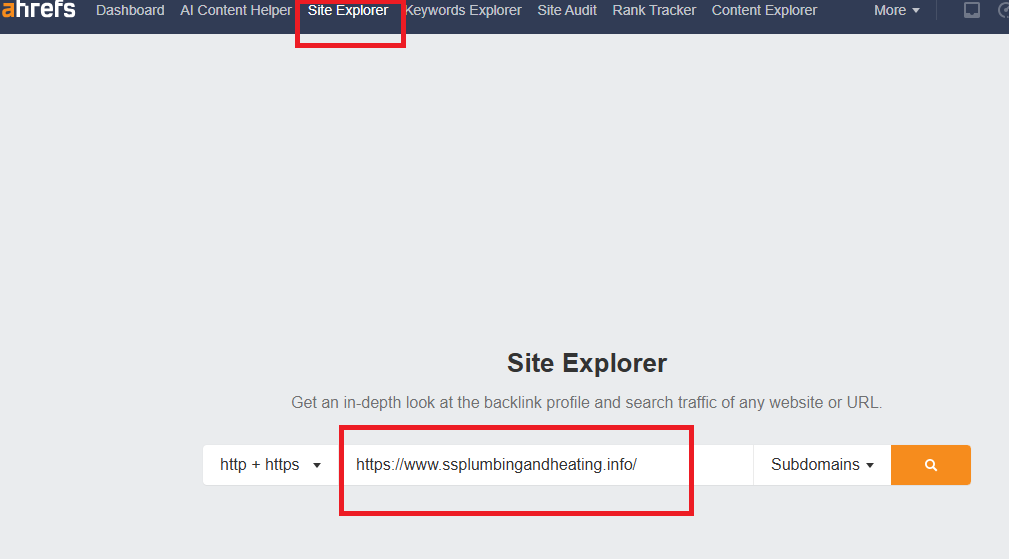
Source
Ahrefs will show you a ton of information on the keyword. However, we are interested in the section “Keyword ideas.” Here, you’ll see keyword ideas grouped into four main areas:
- Terms that include your seed keyword
- Questions related to your seed keyword
- Terms that pages ranking for your keyword also rank for
- Topics that are mentioned in articles featuring your keyword
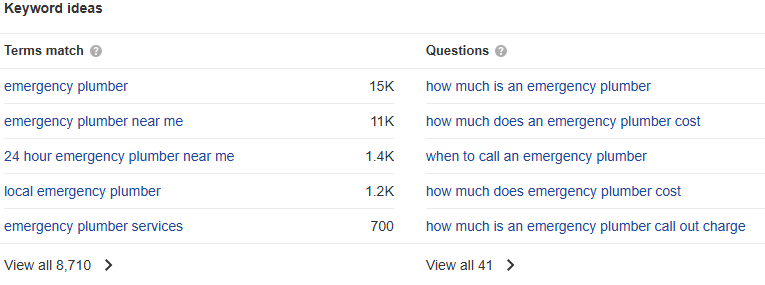
- Step 3: Analyze competitors
You can also use Ahrefs to check what keywords your competitors are ranking for that you might have missed.
First, go to the “Site Explorer” tool and type your competitor’s URL into the search bar.

Next, click “Organic keywords” in the left menu bar.
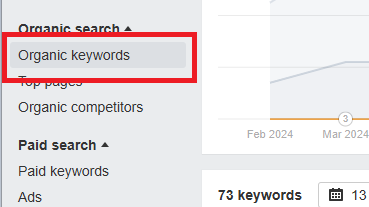
You’ll be presented with a list of keywords that your competitor ranks for.
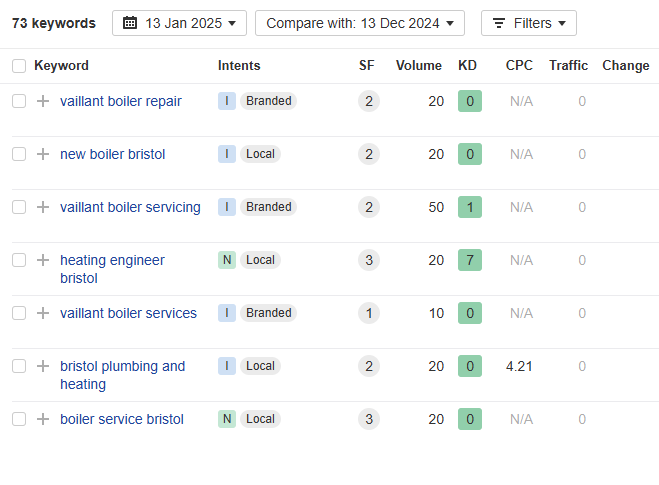
Step 3: Prioritize keywords
Next, determine which keywords you should focus on in your SEO campaigns. Add all of your keywords to a spreadsheet and enter each one into Ahrefs’ Keyword Explorer.
For each one, you’ll be shown a load of information.

For now, the most important data points are:
- Keyword difficulty: How much competition there is to rank for the keyword.
- Search volume: How many people search for the term.
Add these data points to your spreadsheet. The best keywords have high traffic and low keyword difficulty. Use your spreadsheet to find the best opportunities.
Publish quality content
Publishing quality content is crucial for improving your SEO. Here’s why it’s important:
- Boosts your rankings: Search engines favor websites with helpful, well-written content. High-quality content signals that your site is relevant and valuable to users, improving your rankings.
- Engages your audience: When people find informative content, they are more likely to stay on your site longer and return in the future. This reduces bounce rates and improves your SEO.
- Drives traffic: Quality content can attract more visitors by answering common questions and providing solutions to problems.
- Builds trust: Well-researched and clear content positions your plumbing business as an authority in the field, building trust with potential customers.
- Encourages sharing: People are more likely to share helpful, informative articles, which can increase backlinks to your site and improve your SEO.
It’s important that your content is:
- Professionally produced: Readers are more likely to trust it.
- Offers value to readers: If your content is genuinely valuable to them then they are more likely to continue engaging with your brand.
- Is published regularly: New content isn’t immediately searchable on Google. The search engine first has to discover it and then add it to its index. Publishing regularly makes it more likely that search engines will look for new content on your site.
If writing isn’t your strength or you’re short on time, hiring a freelancer or an agency can help ensure the content is top-notch and published regularly.
Here are some examples of the kind of content you can publish:
- How-to guides: Step-by-step instructions on common plumbing problems like fixing a leaky faucet or unclogging a drain.
- FAQs: A list of frequently asked questions that address common plumbing issues, such as “How do I know if my water heater needs repair?”
- Service pages: Detailed pages for each service you offer, like “pipe repair” or “water heater installation.”
- Case studies: Showcase successful projects with before-and-after photos.
- Customer testimonials: Share stories from happy customers to build social proof and trust.
Here’s a good example of some high-quality plumbing content. UK-based My Plumber has published an in-depth guide on how to install a new toilet.
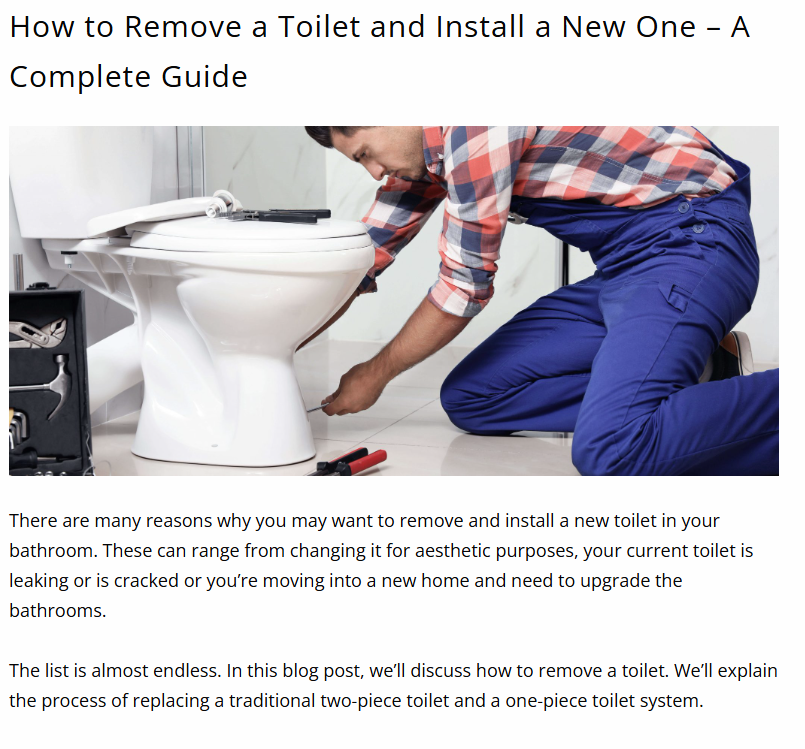
Because this article is so good, it ranks on page one and gets 508 visitors every month.
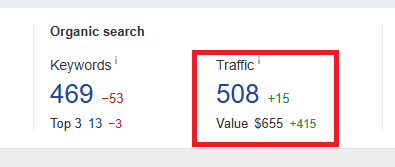
All of these people will see My Plumber’s brand and remember their expertise. They might even get in touch to buy their services.
Build high-quality backlinks
Backlinks are links from other websites that point to your website. When a reputable website links to your site, it acts as a vote of confidence in your content, signaling to search engines that your site is trustworthy and relevant.
What is link building?
Link building is the process of getting other websites to link back to your site. It’s an important part of SEO because search engines like Google use backlinks as a ranking factor.
The more high-quality backlinks you have and the more domains that link to you, the more likely your website is to rank higher in search results.
What makes a good backlink?
Not all backlinks are equal. High-quality backlinks come from reputable, authoritative websites in your industry. They pass on more SEO value than links from low-quality or irrelevant sites.
For example, a backlink from a well-known plumbing association is much more valuable than a link from a random blog.
Link building techniques
Here are some link building techniques your plumbing business can use:
Outreach
Outreach is the process of contacting other website owners to request a backlink to your content. The key here is to have valuable content to offer, like a helpful guide, informative blog post, or case study.
Here’s how to perform outreach:
- Step 1: Identify relevant websites. Look for industry blogs, local businesses, or publications that may be interested in your content.
- Step 2: Create content worth linking to. Publish high-quality articles, like detailed guides or case studies, that provide real value to your target audience.
- Step 3: Craft a personalized email. Reach out to website owners or bloggers and introduce your content. Explain why it would be valuable for their audience and how it relates to their website. Keep the message friendly and professional.
Here’s a template that you can use:
Subject Line: Let’s collaborate – helpful plumbing tips for your audience
Hi [Recipient’s Name],
I hope this email finds you well! My name is [Your Name], and I run [Plumbing Business Name], a local plumbing service in [City/Area].
I came across your website, [Website Name], and was impressed with [specific comment about their website or content, e.g., “the detailed home maintenance tips you share”]. It’s clear that you’re passionate about providing valuable information to your readers.
I wanted to reach out because I believe we share a common goal: helping people take care of their homes. I’ve recently put together a [resource/article], “[Title of Your Resource],” which offers [key benefit of your content, e.g., “practical tips for preventing costly plumbing emergencies”].
I think your audience would find it helpful, and I’d love to collaborate by contributing it to your website or discussing ways we can work together. Whether it’s including a link to my resource or creating a guest post, I’m open to ideas that align with your goals.
Feel free to check out the resource here: [Link to Your Article/Resource].
If this sounds like something you’d be interested in, let me know, and I’d be happy to discuss further.
Looking forward to hearing from you!
Best regards,
[Your Full Name]
[Your Position]
[Plumbing Business Name]
[Phone Number]
[Website URL]
[Social Media Links, if applicable]
- Step 4: Follow up. If you don’t hear back after a week or two, send a polite follow-up email to remind them of your content.
Another effective way to build backlinks is through link insertions, which means getting your link added into existing articles on other sites where it naturally fits.
Guest blogging
Guest blogging involves writing articles for other blogs in exchange for a backlink to your site. This is a great way to build authority in your industry while gaining valuable backlinks.
Here’s how to do guest blogging:
- Step 1: Identify guest blogging opportunities. Look for reputable blogs in the plumbing or home improvement space that accept guest posts.
- Step 2: Pitch ideas. Contact the blog owner with a few topic ideas that would be valuable for their audience. Make sure your topics are relevant and provide value to readers.
- Step 3: Write a high-quality post. Once your pitch is accepted, write an informative, well-researched article. Include a link to your site where relevant.
- Step 4: Engage with readers. After your post is published, interact with readers in the comments to build relationships and promote your expertise.
Here’s a good guest post on the Kitchen & Bathroom Blog. Optimised Plumbing Services explains why inspecting pipes and drains during renovation work is a good idea.
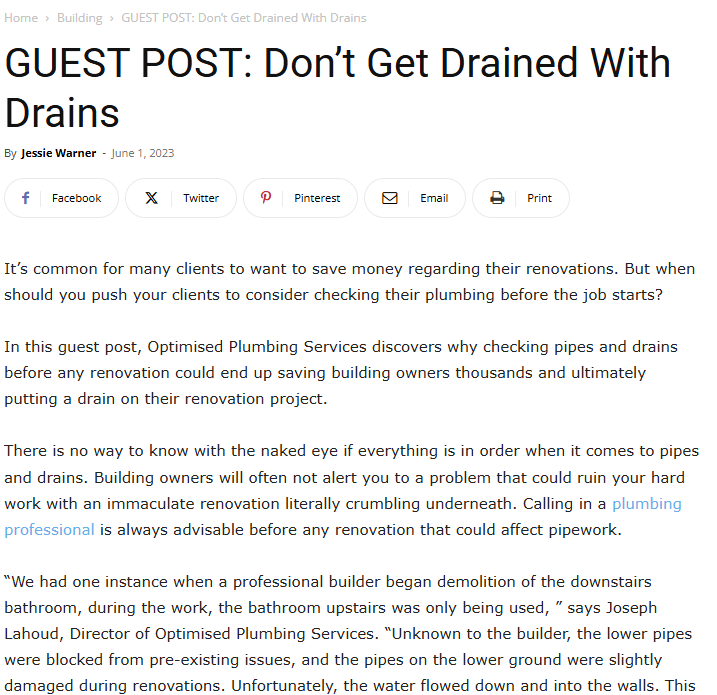
Answer journalists’ questions
Becoming a source for journalists can help you earn backlinks from high-authority news websites. Platforms like Qwoted connect journalists with industry experts to get quotes for their stories.
Here’s how it works:
- Step 1: Build relationships with journalists. Follow journalists in your industry on social media, comment on their articles, and engage with them.
- Step 2: Sign up for platforms like Qwoted. Journalists often use these platforms to find experts for specific topics. Set up an alert for plumbing-related queries.
- Step 3: Provide valuable insights. When a journalist reaches out with a question related to plumbing, respond with a helpful, insightful quote.
- Step 4: Get your backlink. When the article is published, your quote usually includes a website backlink.
Here’s a good example from Michigan Live, in which a plumbing company has been quoted explaining the sewage issues caused around Thanksgiving. It also provides homeowners with tips on how they can avoid these problems.
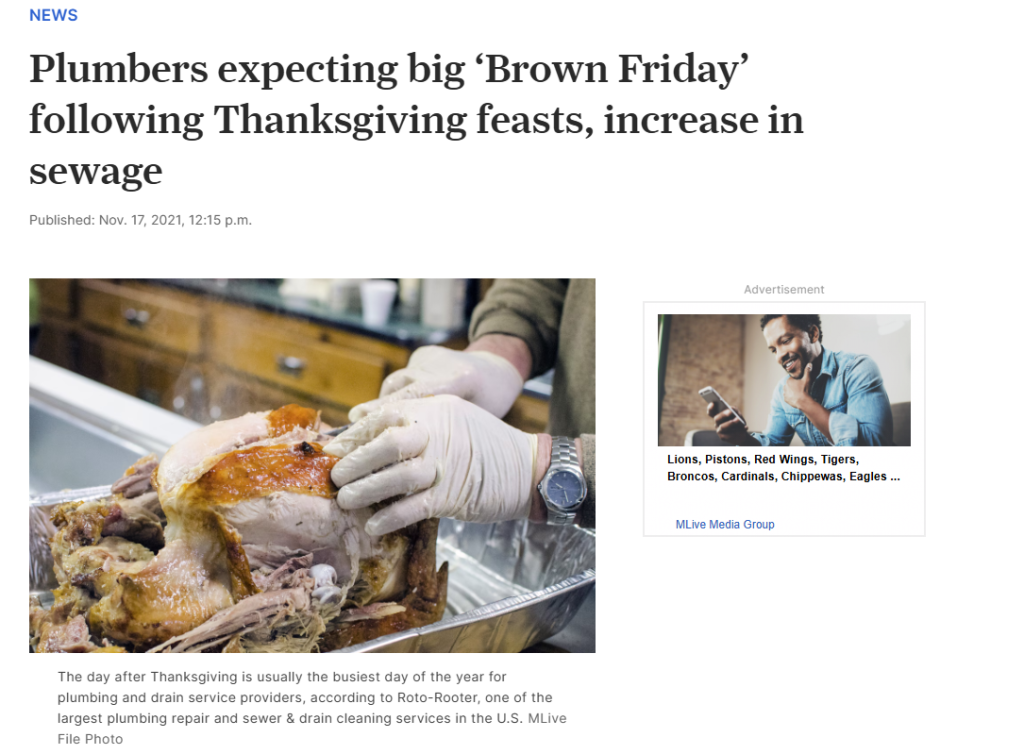
Optimize your on-page SEO
On-page SEO refers to the changes you can make directly on your website to improve your rankings in search results. These improvements ensure that users and search engines understand your content.
Here’s an on-page SEO checklist:
✅ Meta titles: The meta title appears as the clickable text in search results. Make sure the title is clear, includes your main keyword (e.g., “Plumber in [City]”), and is under 60 characters.

✅ Meta descriptions: The meta description is the short text below the title in search results. Write a short description (under 160 characters) that summarizes your page and includes relevant keywords.

✅ Headings (H1, H2, H3, etc.): Headings are the large text on your webpage. The H1 is usually the page title. Make sure the H1 includes your main keyword and accurately reflects the page. Use H2s and H3s for subheadings, and include secondary keywords.
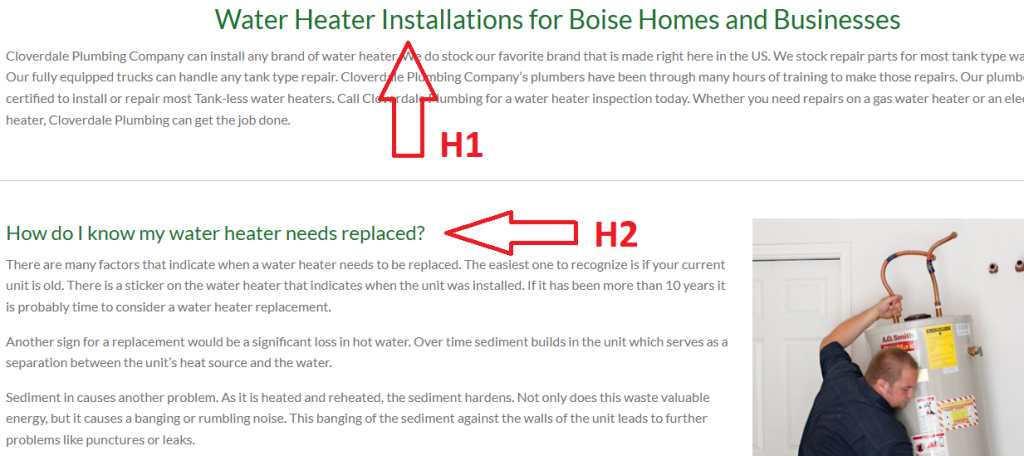
✅ URL structure: The URL is the web address in the browser bar. Use short, descriptive URLs that include relevant keywords. For example, “/plumbing-services/[city]” instead of “/page123.”
✅ Alt text for images: Alt text is not visible on the page but is used by search engines to understand images. Write descriptive alt text for each image, using relevant keywords. For example, “Plumber fixing water heater in [City].”
✅ Internal linking: Internal links are hyperlinks within your content that lead to other pages on your website. Link to other helpful pages on your site, such as your services pages or blog posts.
Technical SEO checklist
Technical SEO refers to the behind-the-scenes factors that improve the user experience. It also helps search engines crawl and index your site more effectively, ultimately boosting your rankings.
Technical SEO can be quite complex, so this section only summarizes factors you need to understand. You may have to speak to an expert to improve them.
✅ SSL certificate (HTTPS): The padlock symbol in the browser bar shows your site is secure (https://). Ensure your website is using HTTPS, which is essential for security and rankings. Contact your hosting provider if you’re not sure how to enable it.
✅ XML sitemap: The sitemap isn’t visible to visitors, but it’s submitted to search engines to help them index your site. If you use WordPress, plugins like Yoast or RankMath automatically generate sitemaps. Make sure to submit your sitemap to Google via Search Console.
✅ Robots.txt file: This file isn’t visible to users, but it helps search engines understand which pages to crawl. Check that your robots.txt file isn’t blocking important pages from search engines. This can be done using Google Search Console.
✅ Page speed optimization: Page speed is how quickly your site loads. Use tools like Google’s PageSpeed Insights to analyze and improve your website speed. Optimize images and reduce unnecessary code to help pages load faster.
✅ Broken links: Broken links are links on your site that lead to pages that no longer exist.
Regularly check your website for broken links and fix them or remove them. Tools like Screaming Frog or Ahrefs can help you find broken links.
✅ 404 pages and redirects: A 404 page appears when someone visits a page that doesn’t exist.
Set up redirects (301 redirects) for any pages that have been removed or moved. This ensures visitors and search engines are sent to the right place.
✅ Mobile-friendliness: Most people access websites using mobile devices these days. This means yours needs to look and operate well on mobile devices. You should ensure your site is responsive, meaning it automatically adjusts to different screen sizes. Google prioritizes mobile-friendly websites in search rankings.
How Authority Builders Can Boost Your Plumbing Business SEO
Improving SEO for your plumbing business involves a combination of publishing quality content, building high-quality backlinks, and optimizing your website’s on-page elements.
By following these strategies, you can boost your online visibility, attract more customers, and ultimately grow your business.
At Authority Builders, we specialize in helping businesses like yours improve their SEO through effective link-building strategies and targeted content. Our team of experts can assist you in earning valuable backlinks and optimizing your site to achieve higher rankings in search results.
Contact Authority Builders today to learn how we can help your plumbing business reach new heights. Schedule a consultation and get started on your journey to better SEO.
